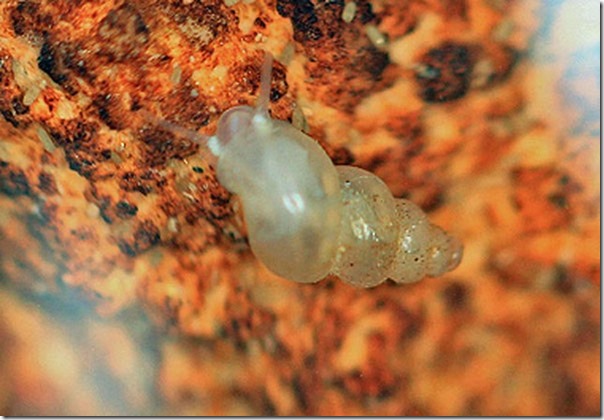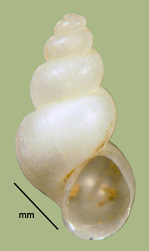> Habitat & Distribution
This stygobiontic hydrobiid has been documented from perhaps 4 - 5 caves and springs in Lee County, Virginia (draining west toward Tennessee), according to the VA Natural Heritage Program database. Holsingeria also apparently ranges through subterranean waters at least 500 km north, up into Skyline Caverns and the drainage of the Shenandoah (Hershler et al. 2003). In Unthanks Cave, the rather small and localized population of Holsingeria inhabits rocks and cobbles in a series of clear pools.
A broad-brush review of the zoogeography of North American cavesnails has been offered by Hershler & Holsinger (1990). FWGNA incidence unranked.
> Ecology & Life History
Hydrobiids seem to be rather nonspecific grazers of small particles (Dillon 2000: 94-97). One might reasonably hypothesize that populations of the blind, unpigmented H. unthanksensis are supported by organic particles raining down from cave ceilings above. I am not aware of any formal study on the life history of Holsingeria populations, although one might hypothesize that the unusually stable environments they enjoy could promote continuous reproduction. Hydrobiids are in general dioecious, the males being characterized by a penis arising from the neck. Eggs are generally laid singly, attached in spare capsules to solid substrates.
> Taxonomy & Systematics
The original description of Hershler (1989) included
observations
regarding the anatomy and morphology of this unusual taxon of
hydrobioid
snails. Holsingeria
apparently belongs
to the family Lithoglyphidae, characterized by a simple
penis (Kabat & Hershler 1993), although none of the other
aspects
of its biology are even remotely lithoglyphid. The taxon made
a
cameo
appearance among the outgroups in a molecular phylogeny of the
nymphophiline hydrobiids published by Hershler and colleagues (2003).
> Maps and Supplementary Resources
- Fontigens and Holsingeria in Atlantic drainages (2023)
- Hydrobiid distributions in the Tennessee/Cumberland (2022)
- Photo of H.
unthanksensis taken in Unthanks Cave March 2013, courtesy of Richard
Kretz.

>Essays
- See my post to the FWGNA blog of 22Aug07 entitled Cave Snail Adventure for field observations and additional photos of H. unthanksensis.
- Earlier versions of this website, online until August of 2016, adopted the large, broadly-inclusive concept of the Hydrobiidae (sl) following Kabat & Hershler (1993). More recently the FWGNA project has shifted to the Wilke et al. (2013) classification system, distinguishing a much smaller Hydrobiidae (ss) and elevating many hydrobioid taxa previously ranked as subfamilies to the full family level. For more details, see The Classification of the Hydrobioids.
> References
Dillon, R.T., Jr. (2000)
The Ecology of Freshwater Molluscs. Cambridge University Press,
Cambridge, United Kingdom.
Hershler, R. H. (1989)
Holsingeria unthanksensis,
a new genus and species of aquatic cavesnail from eastern North
America. Malac. Rev. 21: 93-100.
Hershler, R. H. &
J. R. Holsinger (1990) Zoogeography of North
American hydrobiid cavesnails. Stygologia 5: 5-16.
Hershler, R. H., H-P. Liu
& F. G. Thompson (2003)
Phylogenetic relationships of North American nymphophiline gastropods
based on mitochondrial DNA sequences. Zoologica Scripta 32:
357-366.
Kabat, A.R., and R.
Hershler (1993)
The prosobranch snail family Hydrobiidae (Gastropoda: Rissooidea):
review of classification and supraspecific taxa. Smithsonian
Contributions to Zoology 547:1-94.
Stewart, T. W., &
R. T. Dillon, Jr.
(2004) Species composition and geographic distribution of
Virginia's freshwater gastropod fauna: A review using historical
records. Am. Malac. Bull. 19:
79-91.
Wilke T., Haase M., Hershler R.,
Liu H-P., Misof
B., Ponder W. (2013)
Pushing short DNA
fragments to the limit: Phylogenetic relationships of hydrobioid
gastropods
(Caenogastropoda: Rissooidea). Molecular
Phylogenetics and Evolution 66: 715 736.








